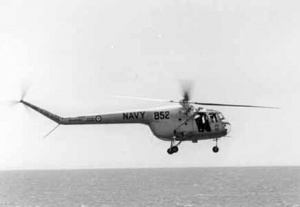The Bristol Sycamore was Britain's first production helicopter, developed by the Bristol Aeroplane Company in the late 1940s. It played a significant role in early rotary-wing aviation, particularly for search and rescue (SAR), military transport and casualty evacuation. The HR.50 and HR.51 variants were assigned to export versions of the the Sycamore.
Following a lengthy review of suitable types, the Royal Australian Navy (RAN) placed its first order for three Bristol Sycamore HR.50s in late 1951. These helicopters arrived in Australia on board the aircraft carrier HMAS Vengeance on 11 March 1953. They were then flown off to the Naval Air Station (HMAS Albatross) at Nowra and taken on charge by 723 Squadron. Except for a short period during October 1956-February 1957 when the Sycamores were part of 724 Squadron they were operated exclusively by 723 Squadron.
A total of 13 Sycamore helicopters (ten being the HR.51 model) were acquired by the RAN, with two embarked in Melbourne during the vessel's delivery voyage to Australia, while the remainder were delivered to Australia as sea freight. Sycamores were to be deployed regularly on board the carriers Sydney, Vengeance and Melbourne, for air-sea rescue duties and general personnel and stores carrying tasks. During their service in the carriers, the Sycamore helicopters operated throughout Australian waters, Southeast Asia and the western Pacific region. Routine maintenance was conducted at Nowra, or on board the carriers, while major overhaul and upgrades was contracted to Bristol Aviation Services at Bankstown Airport, Sydney.
In the early 1960s planning commenced to find a replacement for the Sycamore and in 1964 the new Bell Iroquois helicopters were acquired from the United States. Of the 13 RAN Sycamores six crashed during service. This included 2 lost from HMAS Melbourne in 1957 and one from HMS Hermes in 1961. The 3 others were destroyed in crashes at Maitland (1956), Grafton (1958) and Nowra in 1962. The remaining RAN Sycamores were retired from service in June 1965 and sold to museums.
Specifications
 |
| Type |
Rescue and Training Helicopter |
|---|---|
| Manufacturer |
Bristol |
| Number Ordered |
13 |
| First Delivered |
1953 |
| Last Delivered |
1961 |
| Length |
46 feet 2 inches |
| Height |
12 feet 2 inches |
| Weights | 4050 pounds |
| Dimensions | Wing span: 48 feet 6.75 inches (rotor) |
| Speed | 127 mph (max sea level), 91 mph (cruising) |
| Range |
238 miles |
| Crew |
2 |
| Engines | One 520 hp Alvis Leonides Mk72 7 cylinder radial air-cooled engine |
| Performance |
|
| Ships embarked in |
|
